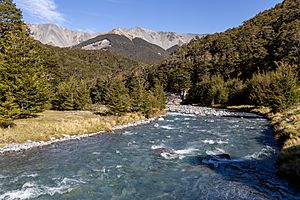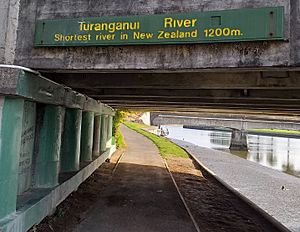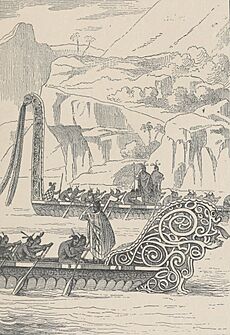Rivers of New Zealand facts for kids
New Zealand's rivers are important for many reasons. People use them for fun, travel, and even to make electricity. However, these rivers also face some challenges, like pollution. In the North Island, many rivers in the hills are deep and flow very fast. This makes them hard to travel on by boat. In the South Island, you'll find many "braided rivers." These rivers look like braids because they split into many small channels that weave together. Long ago, people used the rivers that were easy to travel on for moving goods and people around.
Contents
Amazing Facts About New Zealand Rivers
New Zealand has many rivers, each with its own special features. Here are some cool facts about them.
Longest and Biggest Rivers
The Waikato River is the longest river in New Zealand. It stretches for about 425 kilometers (264 miles). Imagine how long that is!
The Clutha River / Mata-Au is the biggest river when you look at how much water flows through it. It sends about 613 cubic meters (21,648 cubic feet) of water into the sea every second. That's a lot of water!
Shortest River and Long Bridges
The Tūranganui River in Gisborne is said to be the shortest river. It's only about 1,200 meters (3,937 feet) long.
Some rivers have very long bridges crossing them, especially where the land around them is flat. The Rakaia River has the longest bridge in New Zealand, called the Rakaia Bridge. It's an amazing 1,757 meters (5,764 feet) long! Another long bridge is the Whirokino Trestle Bridge, which crosses the Manawatū River.
New Zealand has mapped over 180,000 kilometers (111,847 miles) of rivers. That's a huge network of waterways!
How People Use New Zealand Rivers
Rivers have always been important to the people of New Zealand. They are used for travel, fun, and even to power homes.
Rivers for Travel and Fun
Before European settlers arrived, Māori used rivers a lot for getting around. They traveled in waka, which are canoes made from hollowed-out logs. These waka were perfect for moving along the rivers.
In the early days of European settlement, ships along the coast were the main way to travel. Today, New Zealand still has about 1,609 kilometers (1,000 miles) of rivers that could be used for boats. However, they are not used much for transport anymore.
Now, rivers are popular for exciting activities. People enjoy rafting, canoeing, kayaking, and jet-boating on them. Bungy jumping, which was invented in New Zealand, is also often done over scenic rivers.
Rivers and Electricity
More than half of New Zealand's electricity comes from hydroelectric power. This means using the power of flowing water to make electricity.
Many rivers have hydroelectric power stations built on them. Some stations create a dam that holds back the river's water. Others guide a part of the river's water through the power station. Some big power schemes even use canals to move water between different river systems. This helps them make as much electricity as possible.
Keeping Rivers Healthy: Challenges and Solutions
Keeping New Zealand's rivers clean and healthy is very important. They face challenges like pollution and too much water being taken out.
Pollution in Rivers
In the past, factories and town sewage plants often put their waste directly into rivers. This caused a lot of pollution. Luckily, with more people caring about the environment and new laws like the Resource Management Act 1991, this kind of pollution is less common now.
However, other problems have appeared. Taking too much water from rivers, especially for watering farms, is now a big concern. More and more land is being used for dairy farming. Dairy farms need a lot of water, which puts a strain on river resources. This also means more pollution from farms can get into rivers.
For example, water from the Stockton coal mine has changed the environment of the Mangatini Stream. This mine also causes polluted water to flow into the Waimangaroa River.
Rivers and streams that flow through cities or farming areas often have high levels of pollution.
Protecting Rivers for the Future
A report from the Ministry of Economic Development once said that many rivers could be used to make hydroelectric power. This worried groups like the Green Party and other environmental organizations. They were concerned about losing beautiful rivers and those that are still very natural. Protecting these rivers is important for New Zealand's environment and for future generations.




